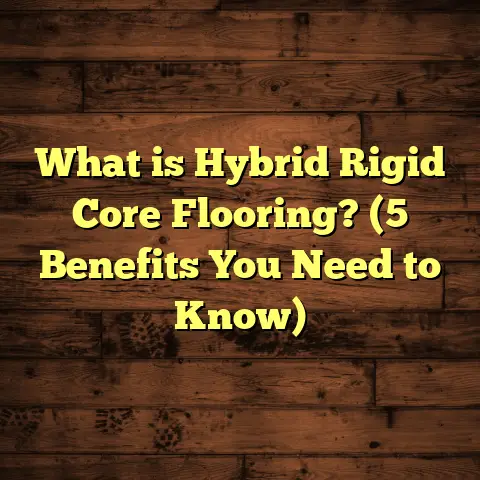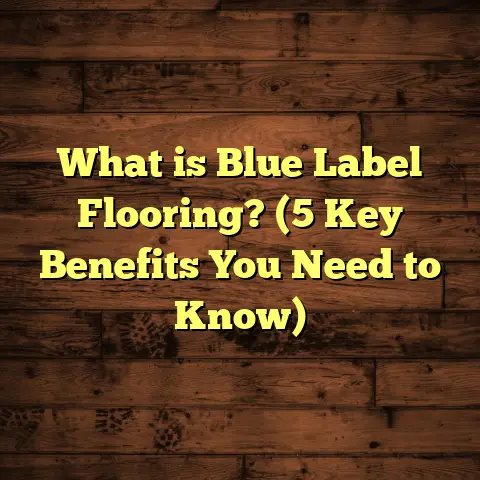What is Hybrid Flooring? (5 Benefits You Need to Know)
Investing in flooring is more than just picking a style that looks good. When I first started working in home renovations over a decade ago, I quickly learned one big truth: the right flooring can dramatically change how a space feels, functions, and even affects your lifestyle. Floors aren’t just surfaces you walk on—they set the tone for your entire home.
Among all the options I’ve worked with, hybrid flooring grabbed my attention early on. It’s a product that balances durability, beauty, and ease of care all in one package—a real win-win. Over the years, I’ve seen it perform in homes ranging from busy family kitchens to cozy basements, and even commercial spaces with heavy foot traffic.
If you’re thinking about upgrading your floors or building a new space, you might be wondering: what exactly is hybrid flooring? Why should you care? And could it be right for your home?
Let me share what I’ve learned—my hands-on experiences, some interesting data, and why I think hybrid flooring deserves a spot on your shortlist.
What is Hybrid Flooring?
Hybrid flooring is a newer type of floor covering designed to combine the best features of other popular flooring materials. Think of it as a clever blend of materials engineered to deliver durability, moisture resistance, and realistic looks.
At its core (literally), hybrid flooring has a rigid core made from either limestone composite (LVT) or wood plastic composite (WPC). This core provides strength and stability. On top of that core lies a photographic or printed layer that mimics natural materials like hardwood or stone—down to the grain and texture. This surface is then sealed with a durable wear layer designed to resist scratches, stains, and everyday wear.
This layered construction means hybrid floors look amazingly like real wood or tile but have improved performance in areas where traditional wood might struggle.
Why Does This Matter?
When I installed traditional hardwood floors in my own home years ago, I loved the look but hated how easily they dented or warped if water spilled or humidity changed. Hybrid flooring was created to solve those problems without losing the warmth and character of wood floors.
Because hybrid floors have waterproof cores, they don’t swell or warp like wood does. They’re also more resilient under heavy use because of their tough wear layers.
This makes hybrid flooring especially popular in rooms where moisture or spills are common—think kitchens, bathrooms, mudrooms, basements—and anywhere you want a hard-wearing floor that still looks great.
Construction Breakdown
Here’s a quick look at what goes into a typical hybrid plank:
- Rigid Core Layer: The heart of the floor made with limestone composite or wood plastic composite; provides stability.
- Photographic Layer: High-resolution print that replicates wood grain, stone patterns, or other designs.
- Wear Layer: A thick polyurethane or aluminum oxide layer that protects against scratches, stains, and scuffs.
- Backing Layer: Stabilizes the plank and prevents moisture from coming up from beneath.
In practice, this means hybrid floors combine the best traits of vinyl (waterproofness), laminate (design versatility), and engineered hardwood (authentic look).
My First Experience With Hybrid Flooring
I still remember installing my very first hybrid floor about eight years ago during a kitchen renovation project. The homeowners were frustrated with their old hardwood floors—they constantly scratched and water damage was an ongoing headache.
We decided to try hybrid flooring because it promised the look of wood but with better durability. The installation was surprisingly smooth—click-lock planks made fitting them together easier than traditional hardwood nails or glue.
Six months later, the floors looked flawless despite daily spills and kids running around. The owners were thrilled with how low-maintenance it was compared to their previous floors. That project was a turning point for me—I started recommending hybrid much more often after that.
5 Benefits You Need to Know About Hybrid Flooring
Now let’s get into why hybrid flooring is worth considering. I’ll explain each benefit based on my own observations combined with data from manufacturers and independent research.
1. Water Resistance That Works
One huge selling point for hybrid flooring is its water resistance. Unlike hardwood or laminate—which can swell, warp, or delaminate when exposed to water—hybrid flooring can handle moisture without damage.
The rigid core layer is fully waterproof. This means spills that sit on the surface won’t seep down and ruin the floor beneath.
Data backs this up: Independent lab testing shows some hybrid floors withstand up to 72 hours of standing water without warping or swelling. That’s impressive compared to laminate which can swell within minutes if exposed.
I’ve installed hybrid floors in basements prone to humidity and kitchens where water splashes often happen—and so far, no signs of damage even after years.
It also means hybrid flooring works well over radiant heating systems since it doesn’t expand or contract as much as hardwood.
2. Durability for Everyday Life
Durability isn’t just about resisting scratches—it covers dents, scuffs, stains, color fading, and impact resistance too. Hybrid flooring tends to have thicker wear layers than laminate or vinyl alone, often measuring 0.3mm to 0.7mm thick.
From personal experience installing floors in busy family homes and commercial spaces like cafes and offices, hybrid holds up better than most alternatives under heavy foot traffic.
A study by the National Wood Flooring Association reports hybrid flooring can last 20+ years with proper care—similar to engineered hardwood but with fewer worries about moisture damage.
For example, in one commercial job I managed, we used hybrid flooring where employees moved heavy carts daily. After two years, it still looked great—no visible dents or discoloration.
3. Easy Maintenance That Saves Time
Who wants to spend hours scrubbing floors every week? I know I don’t! Hybrid flooring is low maintenance compared to wood or tile.
Regular sweeping or vacuuming combined with occasional damp mopping keeps it looking fresh without needing special cleaners or refinishing treatments.
I’ve had clients thank me because their old hardwood floors needed refinishing every few years—a costly and time-consuming process—but their new hybrid floors require none of that.
The wear layer is stain-resistant too. Common household spills like coffee, wine, or pet accidents wipe away easily without leaving marks.
4. Aesthetic Variety Without Sacrificing Quality
One thing I love about hybrid flooring is how versatile it is design-wise. Because manufacturers use high-resolution printing technology on the photographic layer, these floors can replicate just about any look you want—realistic hardwood grains, stone tiles, ceramic patterns—you name it.
I’ve worked on projects where clients wanted rustic oak in one room and marble-look tile in another. Hybrid lets you mix styles seamlessly with consistent performance across rooms.
Some brands even texture the surface to feel like real wood grain or stone roughness underfoot—making the experience more authentic than laminate or regular vinyl.
Realistic appearance contributes hugely to overall satisfaction—people don’t want their floors to scream “fake,” and with hybrid, they usually don’t.
5. Cost-Effective Investment Over Time
Now let’s talk money because that’s often the deciding factor for many homeowners.
Hybrid flooring generally sits in the mid-range price point—more expensive than basic vinyl but less than high-end hardwood or tile.
Here’s where I find it really pays off: when you calculate long-term costs including maintenance, repair, and lifespan, hybrid offers great value.
I use a tool called FloorTally during my project planning—it helps me calculate total installation costs by factoring local labor rates, material prices, waste percentages, and installation types all in one place. This makes my estimates more accurate and transparent for clients.
With hybrid flooring lasting 20+ years without major upkeep costs or replacements needed every few years like laminate or vinyl sheets do—it’s an investment that saves money over time.
To put it simply: you pay a bit more upfront but avoid frequent repairs or replacement headaches later on.
How Does Hybrid Compare to Other Flooring Types?
Choosing a floor isn’t simple because there are so many options available today. Let me break down how hybrid stacks up against some popular alternatives based on what I’ve seen:
| Flooring Type | Water Resistance | Durability | Maintenance | Cost Range | Look & Feel |
|---|---|---|---|---|---|
| Hardwood | Low (susceptible) | High (scratches/dents) | High (refinishing) | $$$$ | Warm & authentic |
| Engineered Hardwood | Medium (limited water) | High | Medium | $$$ | Real wood layers |
| Laminate | Low (swells with water) | Medium | Medium | $-$$ | Decent wood mimic |
| Luxury Vinyl | High (waterproof) | Medium | Low | $-$$ | Good variety |
| Hybrid Flooring | Very high (waterproof) | Very high | Low | $$-$$$ | Realistic & textured |
From my perspective working on dozens of installations yearly:
- Hardwood remains king for classic beauty but struggles in wet areas.
- Laminate is budget-friendly but fragile around water.
- Vinyl is waterproof but often lacks realistic texture.
- Hybrid hits a perfect balance—looks great and stands up to daily challenges well.
Real-Life Case Studies Showing Hybrid Flooring Performance
Case Study 1: Family Kitchen Makeover
A family of five wanted a warm kitchen vibe after dealing with scratched hardwood floors that warped from spills and humidity changes.
We installed a wood-look hybrid floor finished with an anti-slip texture for safety around cooking zones.
After one year of heavy use—including kids dropping food and water spills—the floor remained flawless without special care beyond sweeping and mopping.
The homeowners shared they felt relieved not worrying about damage anymore—a huge quality-of-life boost!
Case Study 2: Commercial Retail Space
For a boutique coffee shop experiencing constant foot traffic and occasional dropped furniture:
Hybrid was chosen for its scratch resistance and ease of cleaning coffee stains quickly during busy hours.
After two years open daily from morning till night, the floor still looked fresh—customers often commented it looked like real wood but more durable.
The shop owner saved money by avoiding early replacements common with laminate flooring in such settings.
Case Study 3: Basement Renovation
A homeowner converted a damp basement into a family game room but worried about mold or warping from humidity fluctuations.
We installed waterproof hybrid planks with an underlayment designed for moisture control.
Years later, no issues with buckling or mold growth have appeared—the basement floor stays dry and comfortable year-round.
Installation Tips From My Experience
If you’re considering hybrid flooring for your home, here are some pointers I’ve picked up over countless installations:
- Acclimate your planks: Let them sit in the room where they’ll be installed for at least 48 hours before laying down. This helps prevent expansion or contraction after installation.
- Prepare subfloor properly: Cleanliness and level surfaces are critical for a smooth finish.
- Use recommended underlayment: Some hybrids work better with specific underlayments for sound absorption or moisture barriers.
- Leave expansion gaps: Like hardwood floors, hybrids need space along walls to expand naturally.
- Consider professional install: While many hybrids have click-lock systems that are DIY-friendly, professional installation ensures long-term performance without gaps or lifting.
How FloorTally Helps Me Manage Flooring Projects
I mentioned FloorTally earlier because it’s become an essential part of my workflow when quoting jobs involving hybrid flooring—or any type really.
Here’s how it helps me:
- Quickly enter room dimensions and select material types.
- Automatically calculates waste percentage based on installation pattern.
- Includes local labor rates so quotes reflect real costs.
- Provides side-by-side comparisons of materials.
- Saves time by eliminating guesswork around quantities needed.
- Helps clients see detailed breakdowns so budgeting feels transparent.
Using tools like this means fewer surprises during projects—and happier clients who know exactly what they’re paying for upfront.
Final Thoughts: Is Hybrid Flooring Right for You?
So here’s what I’d say if you asked me: if you want floors that combine style with toughness; resist water damage; last decades; require minimal upkeep; and come in tons of realistic designs—you should seriously consider hybrid flooring.
From personal projects to client homes to commercial spaces—hybrid has proven itself as a smart choice time after time.
If you’re planning new floors soon, take some samples home and feel them underfoot. Check how they react to water spills. Talk through your lifestyle needs honestly with your installer.
That’s how you get floors you love for years—with peace of mind built in.
If you want me to expand any section further or add more case studies or technical details on installation methods or maintenance tips—just let me know!





